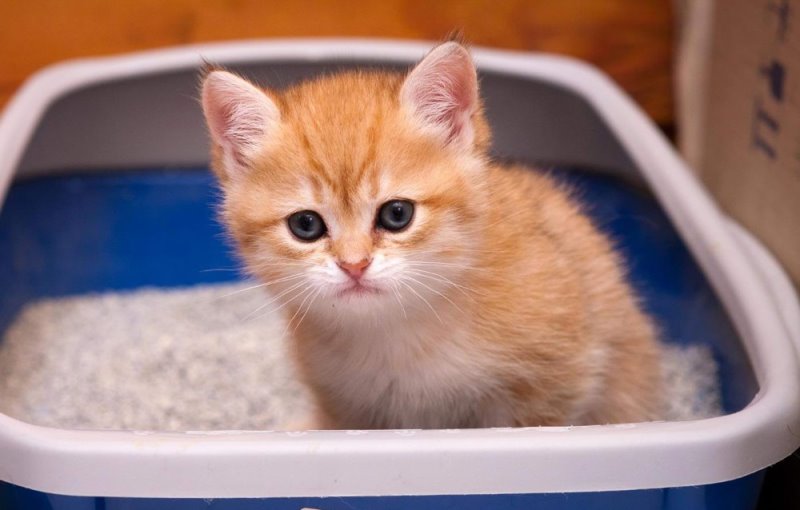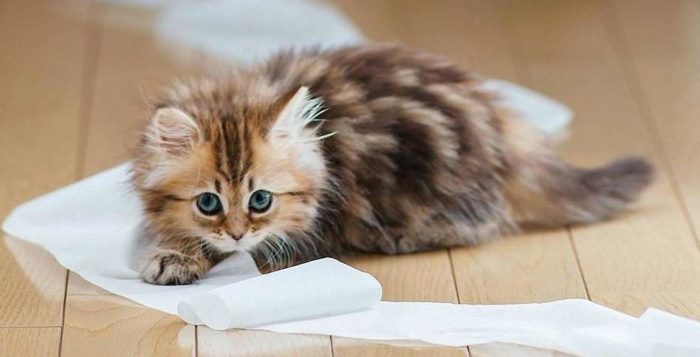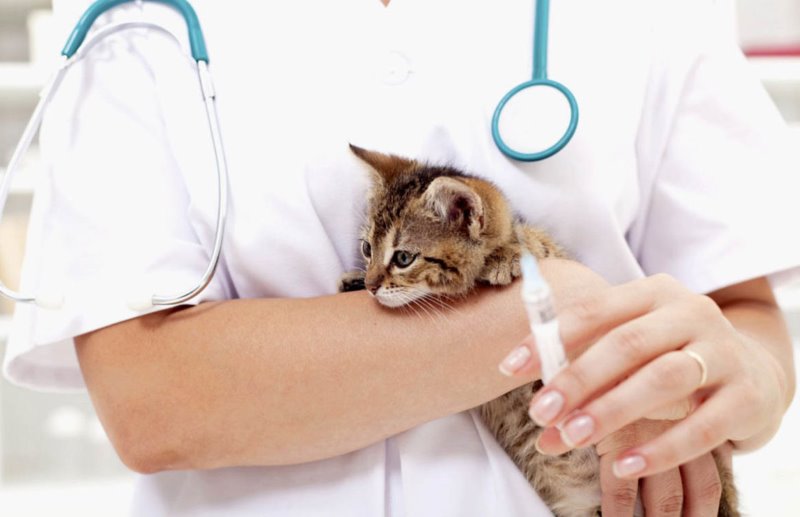Yellow diarrhea in a kitten is a common phenomenon associated with the rapid passage of stool masses through the intestines. Typical causes of pathology: infection, worms, allergies, lactose intolerance. First of all, it is necessary to normalize the stool, and then, based on the diagnosis, think what to do.
Contents
Why diarrhea is yellow?
In a healthy cat, bile enters the intestine, including bilirubin, which has a yellow color. When the food passes through the intestines, bilirubin under the action of digestive enzymes becomes styrkobin, which already has a brown color, and it gives a feces a characteristic shade.
When a cat has diarrhea, the intestinal peristalsis intensifies, which causes the food to move too fast through the intestines, and bilirubin simply does not have time to become a steroclinic. For this reason, diarrhea is usually a light brown, almost yellow hue.
Another mechanism is also possible. When a cat has jaundice of the liver or outside of liver origin, then its blood contains an increased number of bilirubin, part of which is in the intestine. With jaundice, diarrhea becomes bright yellow, sometimes even orange.
To cure diarrhea in the kitten, it is necessary to have blood tests and liver tests, although the therapy itself is based on general principles.
Kittens are normal in feces not brown, but light brown in color. This is due to the small size of the body, because of which the feces pass through the intestines fairly quickly. Consistency is usually pasty due to the fact that the kitten feeds on the mother’s milk. Pathology is a liquid orange or yellow diarrhea in a newborn kitten.
Basic information
You need to know that young or old enough to suffer from diarrhea. Because in young animals the digestive and immune system is not yet able to fully perform its functions, and the old cats are no longer capable.
Note that diarrhea in kittens at 2 months in the vast majority of cases, a special threat to the animal is not, and usually indicates the lack of digestibility of lactose. But if the diarrhea is too frequent or the kitten becomes sluggish, then you need to contact the veterinarian.
Important! The danger of diarrhea is that due to it, dehydration quickly occurs and the water-electrolyte balance is disturbed, especially for kittens. Due to the violation of water-salt metabolism, diarrhea only increases, as a result, a rather dangerous situation occurs for the life of the animal.
To understand that your cat is dehydrated is quite simple. It is necessary to take the animal by the scruff and quickly release, if the crease is straightened, everything is fine, your pet does not dehydrate. If the crease remains for a long time, you should immediately consult a doctor.
Possible causes of diarrhea
It is difficult or impossible to diagnose without instrumental examination and laboratory blood tests in most cases. Jaundice and pain in the right hypochondrium indicates problems with the liver, but information about the exact causes will not.
Causes:
- Liver cancer (in small kittens – an extremely rare phenomenon).
- Sugar or diabetes insipidus.
- Viral or bacterial infection.
- Infection with helminths.
- Strong stress.
- A sharp change in diet.
- Food poisoning.
- Lactose intolerance.
- Binge eating.
As you can see, there can be many reasons, in any case it is worth immediately contacting the vet.
Inspection of faeces
Color, consistency, odor, and also the time of diarrhea after feeding can tell a lot about the causes:
- The rapid development of yellow diarrhea can indicate food poisoning.
- The increase in temperature indicates the infection of the pet’s body.
- Vomiting indicates inflammation in the stomach, perhaps the kitten has gastroenteritis.
- Fecal matter with mucus that have a terrible smell is a direct sign of an intestinal infection or the presence of parasites.
- Pale or white feces with a curdiness consist of a sign that the cat does not have a liver (bilirubin is not produced).
- Feces with blood indicate damage to the gastrointestinal tract, along with a yellow shade of feces, can be suspected helminths, which damaged the wall of the intestine.
Home treatment
If diarrhea is caused not by overfeeding the animal or by reacting the body to the introduction of a new food, it is necessary to immediately contact the veterinary clinic.
If the cat’s health state does not cause fear, it is possible to carry out treatment at home, following the following recommendations:
- The cat should always be under your supervision, and, the younger the animal, the more urgent this rule, because acute diarrhea is accompanied by a sharp dehydration of the body. What a month’s kitten can cause death within two hours. To prevent this situation, you must constantly monitor the situation.
- It is necessary to provide the animal with a sufficient amount of water. To reduce the load on the gastrointestinal tract and prevent the development of secondary infection, for boiling should use only boiled water.
- After each act of defecation, the cat needs to wash the base of the tail and the surrounding areas with warm water using soap, since the bilirubin contained in the feces may cause irritation of the skin of the animal. In addition, if there are helminths in the stools of bacteria or eggs, the kitten can get a second infection.
- If the reason for diarrhea is the overfeeding of the cat, it is recommended to include in its diet pumpkin puree, which is given one tablespoon 2-3 times a day. You can use the children’s puree from the store, which is also very fond of cats.
- We draw your attention to the fact that during the illness and treatment in any case it is impossible to vaccinate the animal, as this can lead to serious consequences, because the organism of your pet is very weakened. It is necessary to refuse vaccination, even if its calendar period has approached.
Treatment in the clinic
Important! If the diarrhea does not go away within 1-2 days, then immediately contact the veterinarian, since the kitten’s body obviously does not cope with the pathology on its own.
The doctor can help you seriously:
- First of all, a microscopic examination of a stool sample with culture on nutrient media is carried out. Feces are taken before sowing antibiotics, otherwise the results of the study will be distorted.
- When bacterial infection is prescribed antibiotics, which are selected based on the type of microbes.
- In case of virus infection, antiviral drugs are prescribed, which are also selected on the basis of the strain of the virus.
- If it turns out that the cause of diarrhea are parasitic worms, anthelminthic (anthelmintic) drugs are prescribed.
- In case of diarrhea caused by poisoning, toxin is detected, and antidotes are used (if any). There are cases when there is a suspicion of poisoning, but it is impossible to determine the toxin. Then the symptomatic treatment is applied. Intoxication with intravenous administration of buffer formulations is removed. A blood transfusion is prescribed, which can be done only in the advanced veterinary clinics in which there is a blood bank.
- When improving the general condition of the animal, he is given a light diet for 14 days, after which the kitten is gradually returned to the normal diet.




















